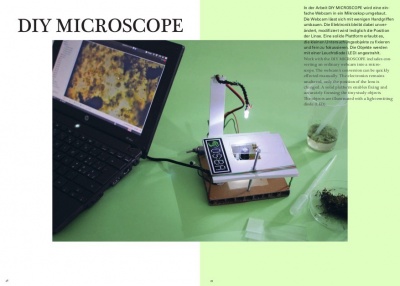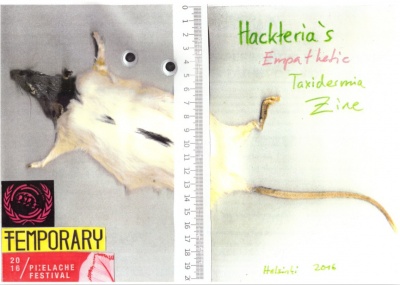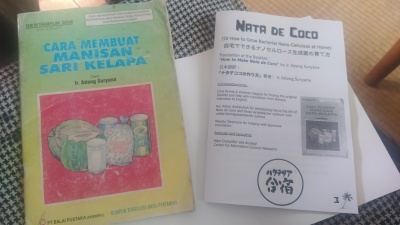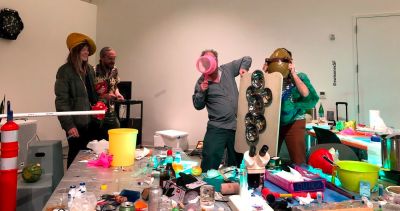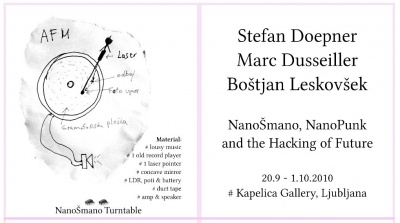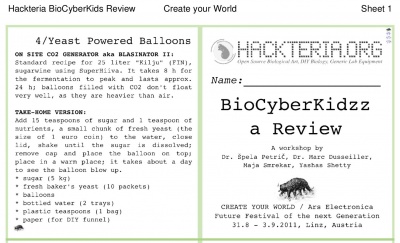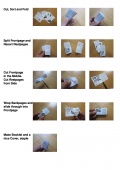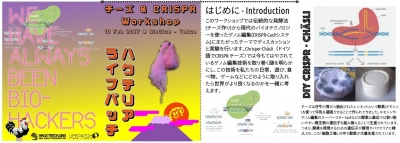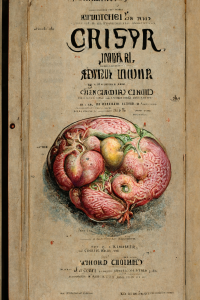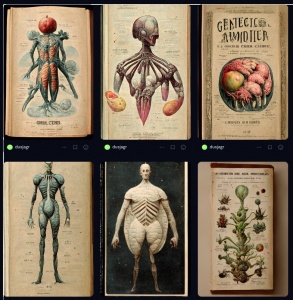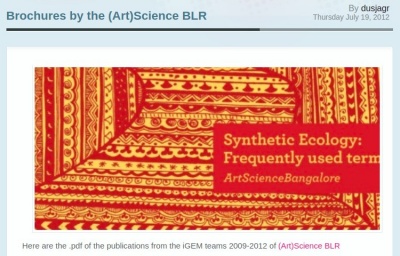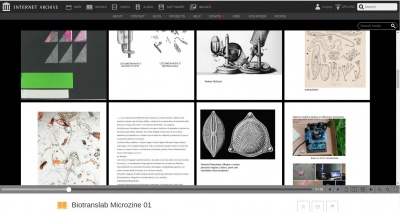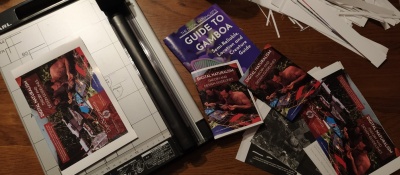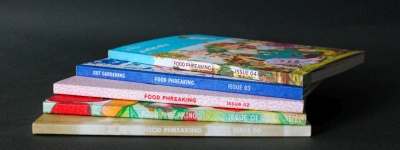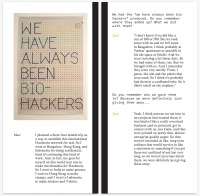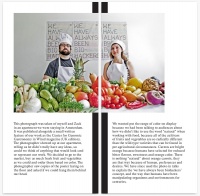Zines
Starting this portal wiki page to all the zines collected from the network...
Contents
- 1 Zines from Hackteria Workshops/Labs
- 1.1 Transgenic Human Genome Alternatives Project - thGAP
- 1.2 DIY Microscope
- 1.3 Hackteria's Empathetic Taxidermy Zine
- 1.4 Almost DONE: Nata de Coco (Or How to Grow Bacterial Nano-Cellulose at Home)
- 1.5 In Progress: Mémoires from Germline Hacks and Body Mods
- 1.6 Short guide to soil microscopy
- 1.7 Short guide to circular soil chromatography
- 1.8 Short guide to fungal bioreactors
- 2 Small publications from Hackteria Workshops/Labs
- 3 Zines from Friends in the Network
- 3.1 artScience BLR - IGEM publications
- 3.2 Mary Maggic - Estrogen and others
- 3.3 Aga's and Agryfp's FermentLab Zines
- 3.4 Pin's BioTransLab and others
- 3.5 Hiking Hack and Dinacon booklets
- 3.6 Foodphreaking - Center for Genomic Gastronomy
- 3.7 WE HAVE ALWAYS BEEN BIOHACKERS - Center for Genomic Gastronomy
- 3.8 Gasthaus: Fermentation and Bacteria & Sonmas recipes
- 3.9 Others
Zines from Hackteria Workshops/Labs
Transgenic Human Genome Alternatives Project - thGAP
See more on Mind thGAP
A reflection on the workshops series Mind thGAP - Transgenic Human Genome Alternatives Project, and an invitation to collaborate on the CGCB - Creative Germline Construct Bank, an online open source bioinformatics database of diverse genetic constructs for germline entry using the GOSHPA - General Open Source Plasmid for Human Arts, as a chassis for transgene infection into a newly fertilized ovum.
Adam Zaretsky, Marc Dusseiller, Cristian Delgado, Paula Pin, Mary Maggic and many collaborators worldwide. The events were held in early summer 2021 at the Hackteria ZET - Open Science Lab in Zürich, Switzerland, and online.
"Genetically modifying the human germline with novel and creative genomic alterations is more aesthetically nuanced in an orthogonal to the contemporary sense than your average clinical CRISPR baby applique."
Its a zine, and QR code invite to collab and be a part of the only online open source bioinformatics database of diverse genetic constructs for human germline entry. All the CGCB genes were chosen publicly by amateur bioartists, citizen scientists and DIY-BIO hobbyists. used for for transgene infection into a newly fertilized ovum during home IVF, garage human embryo design and transgenic human alternative brood breeding without copyright or proprietary nuisance.
DIY Microscope
Extracted Chapter from "Home Made Bio Electronic Arts" - English/German
Download file here: File:HOMEMADE_microscopyChapter_A5.pdf or view it on our cloud: https://mega.hackteria.org/index.php/s/gWnxQRxc2QkQp2a
Work with the DIY MICROSCOPE includes converting an ordinary webcam into a microscope. The webcam’s conversion can be quickly effected manually. The electronics remains unaltered, only the position of the lens is changed. A solid platform enables fixing and accurately focusing the tiny study objects. The objects are illuminated with a light-emitting diode (LED).
In der Arbeit DIY MICROSCOPE wird eine einfache Webcam in ein Mikroskop umgebaut. Die Webcam lässt sich mit wenigen Handgriffen umbauen. Die Elektronik bleibt dabei unverändert, modifiziert wird lediglich die Position der Linse. Eine solide Plattform erlaubt es, die kleinen Untersuchungsobjekte zu fixieren und fein zu fokussieren. Die Objekte werden mit einer Leuchtdiode (LED) angestrahlt.
Home Made Bio Electronic Arts Do-it-yourself: Microscopes, Sensors, Sonifications - Christoph Merian Verlag / Migros-Kulturprozent: Dominik Landwehr, Verena Kuni (Ed.), 2013
After 2 years of discussions with various people in the field of DIYbio, hackteria and BioArt, Dominik Landwehr and Verena Kuni published a new book in their HomeMade series. This time with the title “Home Made Bio Electronic Arts” they go some steps closer to interfacing the living world with DIY tinkering and electronics, easy accessible instructions for everybody. Additionally some editorial essays and an interview with Gerfried Stocker. A production by Migros-Kulturprozent with the Christoph Merian Verlag.
- Six easy do-it-yourself experimental projects
- For biotechnology and electronics do-it-yourself enthusiasts
“Science for all” is the motto of a new movement which deals with biology and electronics. It applies the do-it-yourself approach, well established in the electronic and computer scene, to natural sciences. Here the boundaries between the arts and sciences are fluid. The artists and scientists who work together in an interdisciplinary manner call themselves “bio-hackers” or “bio-punks” and deliberately continue in the creative tradition of those two movements. Their research is designed to communicate scientific insights which are otherwise reserved for scientists. Home Made Bio Electronic Arts introduces leading exponents and presents six easy do-it-yourself experimental projects.
Download the Full Book "Homemade Bioelectronic Art
Hackteria's Empathetic Taxidermy Zine
Almost DONE: Nata de Coco (Or How to Grow Bacterial Nano-Cellulose at Home)
Still finishing it....
In Progress: Mémoires from Germline Hacks and Body Mods
Started to work on it...
Short guide to soil microscopy
We are happy to announce the publication of our Soil microscopy zines in English, Spanish, German and Indonesian
This booklet was produced in the framework of the project series "UROŠ - Ubiquitous Rural Open Science Hardware" (1), a collaboration of the Global Hackteria Network and mikroBIOMIK Society (2), humus Sapiens, Gathering for Open Science Hardware (3) and Ayllu Cooperativa (4). The artistic community and education laboratory GT22 (5) and it’s HeklabGT22 has offered the research location during "UROŠ Temporary Autonomous Lab" in Maribor 2021.
Microbial ecosystems create the conditions for our survival on planet earth: they establish and modulate all our habitats, our climate as well as our health and mood. Cooperation with microbes is the only reasonable strategy for all larger form of life - including humans.
Fertile soil is the basis of civilization. Empires rise and fall with the cultivation and degradation of land. Industrialized agriculture leads to a loss of soil structure, nutrient degradation and contamination - ultimately breaking down ecosystems and eroding the soil to infertile desert.
Let’s see who actually lives down there. Maybe they are still willing to collaborate.
(1) https://www.hackteria.org/wiki/UROS
(3) https://openhardware.science/
(4) https://www.instagram.com/ayllucoope/
(5) https://gt22.si/
Short guide to circular soil chromatography
We are happy to announce the publication of our Soil microscopy zines in English, Spanish and Indonesian
This booklet was produced in the framework of the project series “UROŠ - Ubiquitous Rural Open Science Hardware” (1), a collaboration of the Global Hackteria Network and mikroBIOMIK Society (2), Humus Sapiens, Gathering for Open Science Hardware (3) and Ayllu Cooperativa (4). Zavod Rizoma (5) has offered the research location during the “Maribor soil week“ in Mai 2022.
Soil is an extremely complex substance: minerals, water, air, organic material and a multitude of living beings come together to create a dynamic self-regulating system. For the analysis of soil properties, many different approaches can be useful, such as physical characteristics, chemical composition and biological diversity.
Circular chromatography of soil extracts is a method of analysis that was developed in the mid- to late 20th century and is still used by “biodynamic” farmers all over the world. Although it’s scientific validity is being disputed, the procedure follows a strict protocol and yields highly reproducible results.
Due to it’s simplicity and the aesthetic value of the chromas, circular soil chromatography is also highly suited for education and as a tool to reconnect farmers, gardeners and the general public to the soil on which their life depends.
(1) https://www.hackteria.org/wiki/UROS
(3) https://openhardware.science
(4) https://www.instagram.com/ayllucoope
Short guide to fungal bioreactors
We are happy to announce the publication of our Fungal Bioreactors zines in English and German
With this ‘short guide’, we present a low-tech method for producing a soil inoculant with an extremely high density and diversity of fungi that can be used for soil regeneration in rural as well as urban areas.
Research and experimentation on fungal bioreactors was conducted within the scope of several projects co-organized by mikroBIOMIK (1), including the collaborative programs “HUMUS sapiens” (2) and “UROŠ - Ubiquitous Rural Open Science Hardware” (3) as well as several workshops, e.g. at the machBar (4) in Potsdam. The production of the booklet was financially supported by the foundation Zukunftsstiftung Landwirtschaft (5).
(2) https://mikrobiomik.org/humussapiens
(3) https://hackteria.org/wiki/UROS
(4) https://machbar-potsdam.de
(5) https://zukunftsstiftung-landwirtschaft.de
Small publications from Hackteria Workshops/Labs
NanoŠmano
"NanoŠmano Zine - NanoŠmano, NanoPunk and the Hacking of Future", published in 2010, as part of First Edition of NanoŠmano, Ljubljana. More info about NanoŠmano - LifeSystem, the third edition, on this wiki.
BioCyber Kidzzz
Hackteria & SGMK BioCyberKidzz
https://www.hackteria.org/workshops/hackteria-sgmk-biocyberkidzz/
File:BioCyberKidzz Labjournal.pdf
File:BioCyberKids_booklet_review_Ars.pdf
Cheese & CRISPR
Download the booklet in Japanese: File:Cheese_CRISPR_booklet_jap.pdf or English: File:Cheese_CRISPR_booklet.pdf
Part of our workshop with lifepatch and BioClub in Tokyo, we wanted to make a Japanese version of the Cheesemaking booklet. See more on Chrisper-Chäsli#Workshop_Fr._10._Feb_2017_-_BioClub_Tokyo
19th Century Anatomy Book of Human Genome Editing using CRISPR (generated using AI)
Experiments with AI (midjourney), text to image, to create a collection of pages of a speculative anatomy book, dated from the 19th century, on the topics of human genome editing and CRISPR.
prompt: 𝖌𝖊𝖓𝖊𝖙𝖎𝖈𝖆𝖑𝖑𝖞 𝖒𝖔𝖉𝖎𝖋𝖎𝖊𝖉 𝖍𝖚𝖒𝖆𝖓, 𝕮𝕽𝕴𝕾𝕻𝕽, 𝖆𝖓𝖆𝖙𝖔𝖒𝖞 𝖇𝖔𝖔𝖐, 19𝖙𝖍 𝖈𝖊𝖓𝖙𝖚𝖗𝖞
See it also on archive.org
Download the file ready for print, double-sided, shortside flip: File:CRISPR_19thCentury_ZinePrint.pdf
Zines from Friends in the Network
artScience BLR - IGEM publications
https://www.hackteria.org/media/brochures-by-the-artscience-blr/
New Links for Download:
DIRT
File:DIRT_artscienceBLR_Handbook-2011.pdf
Synthetic Ecology - Frequently used terms
File:IGEM-Comic-2010_artscienceBLR.pdf
SYNTHETIC BIOLOGY FOR ARTISTS & DESIGNERS
File:Synbio_for_Artists_Handbook_IGEM09_Font_HighFiber.pdf
Mary Maggic - Estrogen and others
Aga's and Agryfp's FermentLab Zines
https://archive.org/details/fermentlab-pixelache-2017-strasbourg-zine-part-1/page/n7/mode/2up
Pin's BioTransLab and others
Spanish Version:
English Version:
- https://archive.org/details/pin-bio-translab/
- For Print: File:Pin_BioTransLab_Zine_ShortSidePrint.pdf
- For Screen: File:Pin_BioTransLab_screen.pdf
Hiking Hack and Dinacon booklets
http://andy.dorkfort.com/andy/digitalnatural/category/pubs/print/
And inspired by our archiving discussions he put them all up on archive.org
Digital Naturalism Theory And Guidelines
Hacking The Wild Making Sense Of Nature In The Madagascar Jungle
and many more: https://archive.org/details/@blorgggg
Foodphreaking - Center for Genomic Gastronomy
THE JOURNAL OF EXPERIMENTS, EXPLOITS AND EXPLORATIONS OF THE HUMAN FOOD SYSTEM
Published by the Center for Genomic Gastronomy
Food Phreaking is the journal of experiments, exploits and explorations of the human food system. Each issue contains stories about the space where food, technology & open culture meet. Food Phreaking Issue 00 is the prequel and contains 38 short stories outlining what Food Phreaking is, and what it is not. Food Phreaking Issue 01 is "A Culinary Compendium of Curious Botanical Fruits". Issue 02 is called "What is In Vitro Meat?", Issue 03, focusses on the human microbiome. Our newest issue uncovers the secret lives of seeds, with short stories and essays written by the Center and various expert contributors around the globe. Food Phreaking Issue 04: Seeds is risograph printed by HATO Press with a 4-color fold out cover and two-color interior. This issue is 100% self-published, thanks to your contributions and continued support. As always, Food Phreaking is licensed under Creative Commons and the full book is available as a free, downloadable PDF below. Thank you and enjoy!
WE HAVE ALWAYS BEEN BIOHACKERS - Center for Genomic Gastronomy
In 2011 I designed a simple poster that stated WE HAVE ALWAYS BEEN BIOHACKERS together with Zack Denfeld. While visiting Bangalore that same year, we had the poster printed by lithography printers who mainly created posters for the local film industry. The initial WE HAVE ALWAYS BEEN BIOHACKERS posters (we can’t remember if we printed 100 or 500) were randomly distributed by ourselves and our friend Yashas Shetty. They were given away at workshops and other events as we travelled between Asia, Europe and North America. Since then, the poster has taken on a life of its own, travelling the world through various networks, both digital and analogue, morphing over time, but with a message that resonates.
This publication documents an attempt at tracing the origin and the path of the poster as it travelled through a community of artists and scientists over the course of a ten year period.
To research this history and map out this path I dug into the collective memory of a handful of people who themselves have a relationship to the poster in one way or another. I conducted online interviews with each of them using various digital platforms, from zoom to Hackteria’s homemade island (island.hackteria.org).
Download it here: File:biohackers-zine-timeline.pdf
Or as printable and foldable booklet: File:biohackers-zine-timeline-book.pdf
